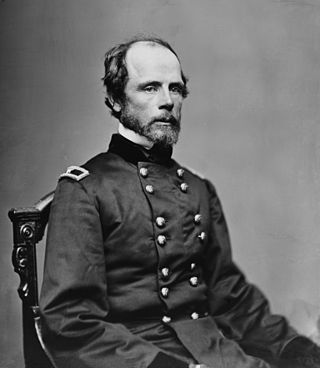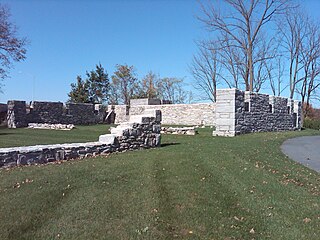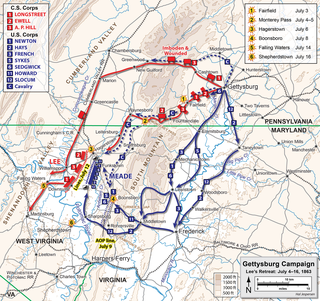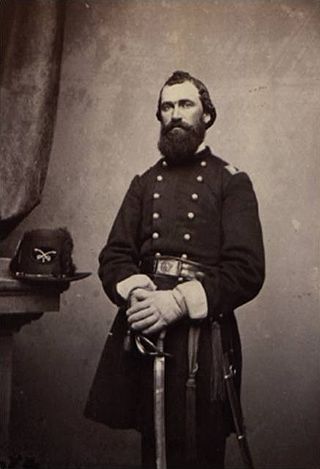Related Research Articles

The Battle of Gettysburg was a major battle in the American Civil War fought by Union and Confederate forces between July 1 and July 3, 1863, in and around Gettysburg, Pennsylvania.

The Battle of the Wilderness was fought on May 5–7, 1864, during the American Civil War. It was the first battle of Lieutenant General Ulysses S. Grant's 1864 Virginia Overland Campaign against General Robert E. Lee and the Confederate Army of Northern Virginia. The fighting occurred in a wooded area near Locust Grove, Virginia, about 20 miles (32 km) west of Fredericksburg. Both armies suffered heavy casualties, nearly 29,000 in total, a harbinger of a war of attrition by Grant against Lee's army and, eventually, the Confederate capital, Richmond, Virginia. The battle was tactically inconclusive, as Grant disengaged and continued his offensive.

Richard Stoddert Ewell was a career United States Army officer and a Confederate general during the American Civil War. He achieved fame as a senior commander under Stonewall Jackson and Robert E. Lee and fought effectively through much of the war. Still, his legacy was clouded by controversies over his actions at the Battle of Gettysburg and the Battle of Spotsylvania Court House.

Darius Nash Couch was an American soldier, businessman, and naturalist. He served as a career U.S. Army officer during the Mexican–American War, the Second Seminole War, and as a general officer in the Union Army during the American Civil War.
The National Civil War Museum, located at One Lincoln Circle at Reservoir Park in Harrisburg, Pennsylvania, is a private 501c(3) nonprofit promoting the preservation of material culture and sources of information that are directly relevant to the American Civil War and the postbellum period as related to veterans' service organizations, including the Grand Army of the Republic and the United Confederate Veterans. The museum serves as the National Headquarters for the Sons of Union Veterans of the Civil War (SUVCW).

The Gettysburg campaign was a military invasion of Pennsylvania by the main Confederate army under General Robert E. Lee in summer 1863. It was the first time during the war the Confederate Army attempted a full scale invasion of a free state. The Union won a decisive victory at Gettysburg, July 1–3, with heavy casualties on both sides. Lee managed to escape back to Virginia with most of his army. It was a turning point in the American Civil War, with Lee increasingly pushed back toward Richmond until his surrender in April 1865. The Union Army of the Potomac was commanded by Maj. Gen. Joseph Hooker and then by Maj. Gen. George G. Meade.

Robert EmmettRodes was a Confederate general in the American Civil War, and the first of Robert E. Lee's divisional commanders not trained at West Point. His division led Stonewall Jackson's devastating surprise attack at the Battle of Chancellorsville; Jackson, on his deathbed, recommended that Rodes be promoted to major general. Rodes then served in the corps of Richard S. Ewell at the Battle of Gettysburg and in the Overland Campaign, before that corps was sent to the Shenandoah Valley under Jubal Early, where Rodes was killed at the Third Battle of Winchester.

William Edmondson "Grumble" Jones was a Confederate cavalry general with a reputation for being a martinet to his troopers and fractious toward superiors, but acknowledged to be a good commander. After disagreements of a personal nature with J.E.B. Stuart, Jones's brigade was set to guarding supply lines and unavailable during a crucial juncture of the Gettysburg Campaign when Lee suffered from a lack of capable reconnaissance cavalry. As the personality clash between Jones and Stuart escalated, Jones faced charges for impertinence, and was transferred to separate him from Stuart. Jones was killed leading a counter-attack in the 1864 Battle of Piedmont.
The Battle of Carlisle was an American Civil War skirmish fought in Pennsylvania on the same day as the Battle of Gettysburg, First Day. Stuart's Confederate cavalry briefly engaged Union militia under Maj. Gen. William F. "Baldy" Smith at Carlisle and set fire to the Carlisle Barracks. Stuart's cavalry withdrew and arrived at the Battle of Gettysburg, Second Day, to the annoyance and concern of Gen. Robert E. Lee.
The Department of the Susquehanna was a military department created by the United States War Department during the Gettysburg Campaign of the American Civil War. Its goal was to protect the state capital and the southern portions of the commonwealth of Pennsylvania, and to deny the Confederate army passage across the vital Susquehanna River.
The Department of the Monongahela was a military department created by the United States War Department during the Gettysburg Campaign of the American Civil War.

Albert Gallatin Jenkins was an American attorney, planter, politician and military officer who fought for the Confederate States of America during the American Civil War. He served in the United States Congress and later the First Confederate Congress. After Virginia's secession from the Union, Jenkins raised a company of partisan rangers and rose to become a brigadier general in the Confederate States Army, commanding a brigade of cavalry. Wounded at the Battle of Gettysburg and again during the Confederate defeat at the Battle of Cloyd's Mountain, during which he was captured, Jenkins died just 12 days after his arm was amputated by Union Army surgeons as he was unable to recover. His former home is now operated by the United States Army Corps of Engineers.

During the American Civil War, the Commonwealth of Pennsylvania played a critical role in the Union, providing a substantial supply of military personnel, equipment, and leadership to the Federal government. The state raised over 360,000 soldiers for the Federal armies. It served as a significant source of artillery guns, small arms, ammunition, armor for the new revolutionary style of ironclad types of gunboats for the rapidly expanding United States Navy, and food supplies. The Phoenixville Iron Company by itself produced well over 1,000 cannons, and the Frankford Arsenal was a major supply depot.

The Skirmish of Sporting Hill was a relatively small skirmish during the Gettysburg campaign of the American Civil War, taking place on June 30, 1863, at various locations in present-day Camp Hill, East Pennsboro Township and Hampden Township in Cumberland County, Pennsylvania. It is known as the northernmost engagement of Robert E. Lee's Army of Northern Virginia during the Civil War.

The history of Harrisburg, the state capital of the Commonwealth of Pennsylvania, United States, has played a key role in the development of the nation's industrial history from its origins as a trading outpost to the present. Harrisburg has played a critical role in American history during the Westward Migration, the American Civil War, and the Industrial Revolution. For part of the 19th century, the building of the Pennsylvania Canal and later the Pennsylvania Railroad allowed Harrisburg to become one of the most industrialized cities in the Northeast.

The 35th Virginia Cavalry Battalion, also known as White's Battalion, White's Rebels and the Comanches, was a Confederate cavalry unit during the American Civil War raised by Elijah V. White in Loudoun County, Virginia in the winter of 1861-62. The battalion was initially raised as border guards along the Potomac River below Harpers Ferry but were ultimately mustered into regular service as part of the Laurel Brigade. Despite this, they continued to play a conspicuous role in the ongoing partisan warfare in Loudoun throughout the war. The battalion was particularly notable during the 1863 Gettysburg Campaign, when it played a prominent role in the Battle of Brandy Station and subsequently conducted a series of raids on Union-held railroads and defensive positions in Maryland and Pennsylvania. The 35th was the first Confederate unit to enter Gettysburg, Pennsylvania.

The Fight at Monterey Pass (or Gap) was an American Civil War military engagement beginning the evening of July 4, 1863, during the Retreat from Gettysburg. A Confederate wagon train of Lt. Gen. Richard S. Ewell's Second Corps, Army of Northern Virginia, withdrew after the Battle of Gettysburg, and Union cavalry under Brig. Gen. H. Judson Kilpatrick attacked the retreating Confederate column. After a lengthy delay in which a small detachment of Maryland cavalrymen delayed Kilpatrick's division, the Union cavalrymen captured numerous Confederate prisoners and destroyed hundreds of wagons.

The Confederate Army of Northern Virginia began its Retreat from Gettysburg on July 4, 1863. Following General Robert E. Lee's failure to defeat the Union Army at the Battle of Gettysburg, he ordered a retreat through Maryland and over the Potomac River to relative safety in Virginia. The Union Army of the Potomac, commanded by Maj. Gen. George G. Meade, was unable to maneuver quickly enough to launch a significant attack on the Confederates, who crossed the river on the night of July 13 into South Mountain through Cashtown in a wagon train that extended for 15–20 miles, enduring harsh weather, treacherous roads, and enemy cavalry raids. The bulk of Lee's infantry departed through Fairfield and through the Monterey Pass toward Hagerstown, Maryland. Reaching the Potomac, they found that rising waters and destroyed pontoon bridges prevented their immediate crossing. Erecting substantial defensive works, they awaited the arrival of the Union army, which had been pursuing over longer roads more to the south of Lee's route. Before Meade could perform adequate reconnaissance and attack the Confederate fortifications, Lee's army escaped across fords and a hastily rebuilt bridge.

Jubal Anderson Early was an American lawyer, politician and military officer who served in the Confederate States Army during the Civil War. Trained at the United States Military Academy, Early resigned his United States Army commission after the Second Seminole War and his Virginia military commission after the Mexican–American War, in both cases to practice law and participate in politics. Accepting a Virginia and later Confederate military commission as the American Civil War began, Early fought in the Eastern Theater throughout the conflict. He commanded a division under Generals Stonewall Jackson and Richard S. Ewell, and later commanded a corps.

Jacob C. Higgins (1826–1893) was a commander of Pennsylvania troops who participated in both major military conflicts of his time, the Mexican–American War and the American Civil War. Among his Civil War commands, he guided the 125th Pennsylvania Infantry regiment under heavy fire during the Battle of Antietam and likewise during the Battle of Chancellorsville. Following the muster out and return home of the 125th PA, the Gettysburg Campaign sent cavalry under Confederate General John D. Imboden to threaten vital railroad resources at Altoona and iron production facilities in the Juniata River watershed; in response, Emergency Militia was organized by Colonel Higgins and minimized this northwestern incursion.
References
- Coddington, Edwin B., The Gettysburg Campaign; a study in command, Scribner's, 1968, ISBN 0-684-84569-5.